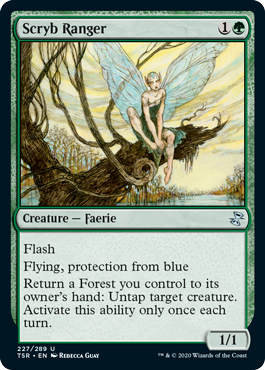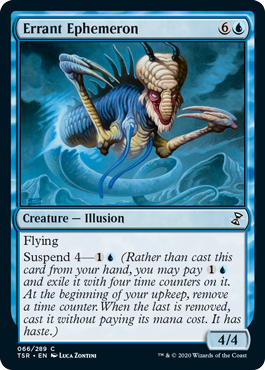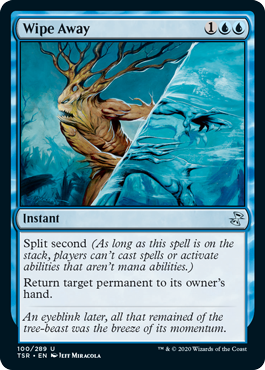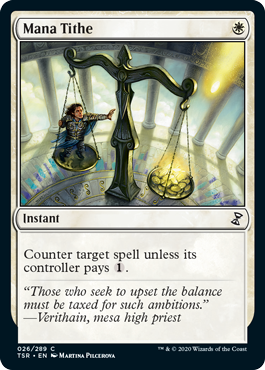27 Things You Might Not Have Known About Time Spiral Block
As we're revisiting Time Spiral block with Time Spiral Remastered, I thought it might be fun to revisit the block's design here in my column. What follows is a lot of interesting behind-the-scenes facts that you may or may not know.
- Time Spiral block brings back a lot of mechanics from the past, but to play into the past, present, and future time motif of the block, I chose a mechanic representing the past, another representing the present, and a third representing the future to premiere in each set. Time Spiral, the set about the past, got flashback, a mechanic all about casting cards you've already cast. Planar Chaos, the present-day set, got vanishing (a tweaked version of the mechanic fading—as this was an alternate-reality set, I thought it was cute that fading was brought back in a slightly alternate form), a mechanic where cards only stick around for a short duration of time. Future Sight, the future set, got scry, the mechanic about looking into the future. It was kind of apropos that Future Sight's mechanic would go on to become evergreen.
- Original Ravnica block, the block before Time Spiral block, was the first full block that I ran as head designer. When I took the job, I had a long list of things I wanted to do. One thing was to take some creature abilities we used all the time and finally keyword them. The lack of keywords had been causing us design headaches for years. Time Spiral block proved to be the perfect place to do that. Flash got introduced in Time Spiral because the whole block had a "time matters" theme. Deathtouch, lifelink, reach, and shroud got introduced in Future Sight on some futureshifted cards. I thought it was funny to tease new keyword mechanics from the future and then immediately make them part of Magic. I also tried to keyword "unblockable" at the time, but we're not consistent enough in how we template it to keyword it.

- Flash, by the way, didn't get proposed originally as a keyword. Instead, I made a much bolder proposition. I wanted to turn instant into a supertype. Instant would mean "this can be played at any time you have priority." Instants would become instant sorceries, and creatures with flash would be instant creatures. The rules manager at the time, Mark Gottlieb, told me that I had come up with a great system had we started it at Magic's beginning, but we were too far into the current system to change it. Mark was the one that then pitched the idea of turning flash into a keyword ability (originally called surprise) that could be put onto any permanent type.
- I originally created hybrid mana for original Ravnica block, but the development team removed it from the set early in development. I was a bit crushed because I really liked the mechanic, but I understood that ideas don't always work for the set they were created for. I'd just have to find a home for hybrid elsewhere. I had my eye on the next block.
- Suspend (called delay at the time) was originally designed for Saviors of Kamigawa. The Champions of Kamigawa block had a legendary theme, and Brian Tinsman and his design team were determined to design a rare cycle of legendary spells. They tried a lot of different things, and they found that big splashy spells that were cheap to cast but took time to resolve were most exciting. When Brian showed the mechanic to me, I told him it was really cool but far too big of a mechanic for one cycle. I said it was the kind of mechanic we could build a whole block around, so I told him to keep looking. I promised him I'd find a home for the mechanic, but it wasn't going to be Saviors of Kamigawa. That cycle ended up introducing the epic mechanic.
- Time Spiral block started out with a story idea. The creative team decided that they needed to change how Planeswalkers worked. Since the beginning of the game, they had had powers akin to a god. Well, it was very hard telling stories where your main characters were gods. To make them relevant and more relatable, we needed to cut down their power level. This led to the Mending, a story where the Multiverse was falling apart and the Planeswalkers had to give up their spark to save it. The event rewrote what it meant to be a Planeswalker. That's what design had to start with.
- I had a story that required something big, bold, and transitional to happen, so I looked at mechanical ideas that I liked and had in reserve, and two things stood out to me—hybrid mana and suspend. Hybrid mana said something was messing with the essence of how mana worked, something that felt chaotic. Suspend said that something was happening with time. I went to Brady Dommermuth, who led the creative team at the time, and said that I wanted to play with these two themes. Could the event involve something with time going crazy, something that was messing up the fundamental nature of the Multiverse? Brady said the story just needed a crisis on an epic scale. What I proposed sounded cool.
- Time Spiral started with a "temporal chaos" theme and made use of both hybrid mana and suspend. We realized quickly that the two mechanics didn't really have any synergy with one another. Yes, we could make suspend spells with hybrid costs, but there wasn't any inherent synergy. The Ravnica development team realized later on that the set was missing some innovation and decided to add hybrid back into the set, but in a small dose (a vertical cycle—a common, uncommon, and a rare for each color combination). This led to hybrid eventually being pulled from Time Spiral.
- Suspend originally wasn't optional. Cards with suspend just took time to resolve. The development team decided the mechanic was better if you opted into using suspend. First, it made the mechanic feel more like upside. Second, it kept the cards from being horrible when you drew them late. Design had solved the last problem by making cards that let you manipulate the time counters on suspend cards. For example, there was a common land cycle that removed a time counter when they entered the battlefield.
- Originally, haste wasn't rolled into the suspend mechanic. We just gave every suspend creature haste regardless of its color. The development team decided it was better to just make it part of how suspend worked.

- The suspend mechanic had a visual cue in the art. You would see a light blue "time wave" that would be covering part of the illustration, and through that wave, you would see the same scene clearly at a different point in time. While this was a very cool visual concept that helped sell temporal shifting, having a one-for-one tie between a mechanic and the art caused endless headaches. For example, it meant that once a card had art, if it had suspend, it had to have suspend, and if it didn't, it couldn't, and it caused a number of problems in development. For years, it was this event that caused us to cut back on tying mechanics to a specific visual identity. It was only the shifting back of our arts waves that let us do it a bit more in recent past.
- In the Time Spiral design handoff, we gave each color its own mechanic from the past. White got kicker, blue got buyback, black got shadow, red got storm, and green got echo. All five colors got a flashback at common and uncommon, as that was the "past" mechanic. We also had a common cycle of Spellshapers. Other mechanics that showed up in cameo (on one to three cards): flanking, madness, amplify, incarnation, landcycling, and cumulative upkeep. Development ended up adding in a lot more repeating mechanics.
- Not every mechanic designed by the Time Spiral design team made it to print. One mechanic was called relentless and allowed creatures to attack twice each turn. Imagine Relentless Attack but stapled to creatures. We felt it could be flavored as creatures that were moving faster in time. (For this and the next mechanic, I sadly couldn't find any examples of cards with the mechanic, just documents referring to them.)
- We also used a mechanic called anchor. These were big creatures for cheap that required a mana payment for upkeep. It was a callback to the many upkeep costs of early Magic and also a way to get in some early hits while waiting for your suspend spells to resolve.
- Here's a splashy cycle that I designed for Time Spiral that never saw the light of day. It used a mechanic I called nostalgia. If this card was in your deck, it allowed you to have four copies of any card from a certain subset in your deck regardless of format restrictions. I was very excited by it, but it was a little too "out there" for R&D.
Nostalgic Veteran
2W
Creature — Soldier
2/3
Vigilant
Nostalgic – 2/3 (As long as this card is in your deck, you may have up to four copies of any 2/3 creature legal in Vintage.)
Nostalgic Wizard
2U
Creature — Human Wizard
1/2
T: Draw a card and discard a card.
Nostalgic – Wizard (As long as this card is in your deck, you may have up to four copies of any Wizard legal in Vintage.)
Nostalgic Zombie
3B
Creature — Zombie
3/1
1B: Regenerate CARDNAME.
Nostalgic – Zombie (As long as this card is in your deck, you may have up to four copies of any Zombie legal in Vintage.)
Nostalgic Bolt
1R
Instant
CARDNAME deals 2 damage to target creature or player.
Nostalgic – 1R (As long as this card is in your deck, you may have up to four copies of any card of the mana cost 1R legal in Vintage.)
Nostalgic Beast
4GG
Creature — Beast
5/5
Nostalgic – Beast (As long as this card is in your deck, you may have up to four copies of any Beast legal in Vintage.)
Nostalgic Artifact
6
Artifact
6,T: Target player draws two cards.
Nostalgic – 6 (As long as this card is in your deck, you may have up to four copies of any card of the mana cost 6 legal in Vintage.)
One of the big pieces of feedback I got was how hard this would be for deck checking at tournaments, so I then tried a slightly different approach of the mechanic that I called gatekeeping, where it let you produce a copy of any card from that subset rather than let you have them in your deck.
Time Recruit
XW
Instant
Put a token into play as a copy of any 2/3 creature.
Time Master
XU
Creature — Wizard Shapeshifter
1/1
As CARDNAME comes into play, you may choose a wizard with a converted mana cost equal to X. CARDNAME becomes a copy of that creature.
Time Zombie
B
Creature — Zombie
1/1
When CARDNAME is put into the graveyard from play, you may pay X. If you do, put a creature token into play that is a copy of any Zombie.
Time Blast
2R
Instant
CARDNAME becomes a copy of any instant with a mana cost of 1R.
Time Wrangler
XGG
Creature — Elf Wrangler
1/1
When CARDNAME comes into play, put a token creature into play that is a copy of any green multicolored creature.
Time Artifact
7
Artifact
As CARDNAME comes into play, you may choose an artifact with a mana cost of 6. CARDNAME becomes a copy of that artifact.
- When I first pitched the concept of a bonus sheet in Time Spiral design, I was worried that people would be resistant to the idea, so I started very small. What if whenever you got a foil card, half of the time it was a cool old reprint instead? Not only was upper management willing to go along with the idea, but they kept asking us to make it more frequent. Before I knew it, the bonus sheet cards were one per pack.
- Aaron Forsythe was put in charge of the Time Spiral timeshifted sheet, and it went through many iterations. About once a week, we'd ask for an update, and Aaron would show us where the timeshifted sheet was currently at. I'm not exaggerating when I say there were probably hundreds of different combinations that Aaron tried.
- For a while, all the cards on the timeshifted sheet weren't going to be Standard legal, so we had a lot of crazy cards on it. We realized, though, that we had a bit of a communication problem. At the time we referred to the sets as "Standard legal." Why could I pull a card out of a Standard-legal set and not have it be Standard legal? We brainstormed answers but realized in the end it was just easiest to make the timeshifted sheet Standard legal. More work for Aaron.
- We spent a lot of time trying to figure out the expansion symbol for the Time Spiral timeshifted sheet. For a while, we toyed with it having a completely different expansion symbol, but we thought that would confuse people. Once we knew it was going to be the same expansion symbol but a different color, we tried a whole bunch of different colors. We decided that we didn't want white, blue, red, or green (black, silver, and gold were already taken), so that basically left yellow, orange, purple, and brown. Yellow ended up being too close to gold, and brown looked ugly, so we were down to orange and purple. We chose purple. Years later, we had to pick the color for the new mythic rare rarity and ended up using orange.
- Originally, the timeshifted sheet was only going to appear in Time Spiral. Including cards from old sets was a slam dunk for the "past" set, but it wasn't quite as obvious how the "alternate present" or "future" sets would use it. Then one day I came up with the idea of preprints, that is, cards from possible potential futures. That seemed like a very exciting timeshifted sheet for Future Sight. But if Time Spiral and Future Sight were going to have one, I felt like Planar Chaos had to have one as well. Ironically, it took us a while to come up with the idea that the colorshifted cards were the timeshifted sheet, even though the idea of colorshifted cards is what led us to do the alternate-reality idea in the first place. (More on this below.)
- I'll start this off with a trivia question that I'll answer at the end of this section. From which booster pack in Time Spiral block can you pull two rares (not counting foils)? While all three sets in the Time Spiral block had a timeshifted sheet, how we put them into each booster pack changed significantly between sets. Time Spiral had one timeshifted card per booster. Planar Chaos had three common timeshifted cards and one uncommon or rare timeshifted card in each booster. (Time Spiral block was before the mythic rarity got introduced into the game.) Future Sight had anywhere from five to ten timeshifted cards in each booster with no guarantee of any rarity. How many timeshifted cards a set's booster included had a lot to do with what role they played in the set. Time Spiral's timeshifted sheet included all reprints, so it was more of flavoring. Planar Chaos and Future Sight had all new cards on their timeshifted sheets, so we wanted to get more of them into the players hands. The answer to the trivia question is Time Spiral and Planar Chaos. The way we did collation for those sets made it possible to open two rares, which wasn't possible with Future Sight.

- Split second (originally called superfast) was originally designed by Devin Low as an Izzet mechanic for Guildpact. We knew they focused on spells, and Devin came up with split second as a way to keep others from messing with Izzet's spells. In the end, the team came up with replicate and decided they liked it better, so split second got shelved. Flash forward to Coldsnap design: Devin was on the design team and reintroduced split second, this time as a means to capture the feel of the old interrupt card type. The Coldsnap design team liked it and put it into the set. Time Spiral development would later be looking for a time mechanic and realized that one was sitting in Coldsnap. (Coldsnap design had started late, and it was a small set, so Time Spiral was in development while Coldsnap was in design.) The development team asked if they could take the split second mechanic, and the Coldsnap design team said it was okay.
- I had a big argument with the marketing department over the advertising plans for Coldsnap. The initial campaign had a tagline like "Rediscover the Past," and I was like, "That's exactly the theme of Time Spiral." It took some arguing, but I finally got them to change it.

- I had to talk Bill Rose into leading the design for Planar Chaos. Bill originally turned me down. He just didn't get my vision for an "alternative present." I ended up designing some cards (including Damnation) as a proof of concept of what I envisioned. Once he saw my take on the alternate color pie, he signed on as lead designer for the set. Interestingly, the card design that really got Bill on board, a white Memory Lapse, sadly did not make it into the set. (Bill had originally designed Memory Lapse for Mirage, but while visiting Wizards to do an interview for a job in R&D, he helped out on a Homelands development meeting and gave them Memory Lapse to fill a hole.)
- Planar Chaos was the closest we've ever come to printing a sixth color. We'd joked about a sixth color for years, but Planar Chaos seemed like an opportune time to introduce it for just one set as it only existed in the "alternate timeline." The color was purple, and the basic land associated with it was at first Cave and then City. We put it into the color wheel between blue and black. Because we were already rejiggering the color pie, we just divided everything into six parts rather than five. As purple would only exist in this set, we juiced the cards. For example, one of them was the card Mana Drain but with purple mana instead of blue. It turned out to be harder to balance than we thought and was pulling focus a little too much, so we ended up dropping it. (One of the designers, Paul Sottosanti, wrote an article all about our purple experiment if you want to know more.)
- When Planar Chaos came out, I answered a bunch of questions on a popular Magic site at the time called MTGSalvation. For all of those who read my blog and know the running joke of people quoting Planar Chaos to me as precedent for a color doing something, I thought you'd enjoy this answer.
"How do you think Planar Chaos will be remembered years from now? How would you like it to be remembered?" – Joyd
I think Planar Chaos will definitely be one of those sets that gets remembered long after it's rotated out of Standard. Mostly because it has such a strong flavor as the "alternate reality/color messing" set. As one of the set's designers, I hope it's remembered fondly. Time Spiral block was definitely an example of design sticking its neck out and trying something very different. I hope this is seen in history as a brave thing and not a dumb one.
- Planeswalkers were originally going to be part of Future Sight on futureshifted cards, but we weren't happy with their design at the time we had to hand off the set to editing, so we replaced them with other cards. Had they appeared in Future Sight, there would have been three—one blue, one black, and one green. While looking through my files when researching this article, I found a bunch of designs for planeswalker cards that I made during Future Sight design. At the time, here's how planeswalkers worked: They came with a certain amount of loyalty. Each turn, they would do one effect (often making you lose loyalty). You would always start with the first effect and then go in order on subsequent turns, wrapping back around to the first one once you did the last one. When they were out of loyalty, the planeswalker went away. (That part stayed.) Here are my designs (interestingly, all for Venser, the blue planeswalker):
Venser #1
3UUB
Planeswalker — Venser
Loyalty – 18
#1 – Tap up to two target creatures. Those creatures do not untap next turn. Venser loses 4 loyalty.
#2 – Draw a card, and Venser loses a loyalty for each tapped creature controlled by an opponent.
Venser #2
3UUB
Planeswalker — Venser
Loyalty – 20
#1 – Target player draws a card. Venser loses 1 loyalty.
#2 – Target player draw two cards. Venser loses 2 loyalty.
#3 – Target player discards any number of cards and then draws that many cards. Venser loses one loyalty for each card discarded in this manner.
Venser #3
3UUB
Planeswalker — Venser
Loyalty – 1
#1 – Choose a creature you control. Venser gains loyalty equal to that creature's power.
#2 – Choose a creature you control. Venser gains loyalty equal to that creature's toughness.
#3 – Pay X loyalty: Gain control of target creature with a combined power and toughness of X.
Venser #4
3UUB
Planeswalker — Venser
Loyalty – 10
#1 – Look at target player's hand. Venser loses one loyalty.
#2 – Name a card. Target player reveals his or her hand and removes from the game all copies of the chosen card. Venser loses three loyalty.
#3 – Venser pays X loyalty to play any card removed from the game by Venser without paying its mana cost, where X is the converted mana cost of the removed card.
"And That's Time. . . Spiral"
I hope you enjoyed my peek behind the scenes of the making of Time Spiral block. As always, I'm eager to hear your feedback, whether it be about today's articles, any of the stories I told, Time Spiral block, or Time Spiral Remastered. You can email me or contact me through any of my social media accounts (Twitter, Tumblr, Instagram, and TikTok).
Join me next week for some card-by-card design stories from cards reprinted in Time Spiral Remastered.
Until then, may you have as much fun playing Time Spiral block as we had making it.
#813: TSP with Aaron Forsythe
#813: TSP with Aaron Forsythe
32:18
Aaron Forsythe and I share memories about working on the design of Time Spiral.
#814: Trivia – Shortest Names
#814: Trivia – Shortest Names
30:11
This is another of my trivia podcasts where I give clues and you try to guess the card before I reveal it. This podcast's topic—the shortest names in Magic.
- Episode 812 Timeshifted Sheets
- Episode 811 Mark Tedin
- Episode 810 Arabian Nights with Richard, Part 2

